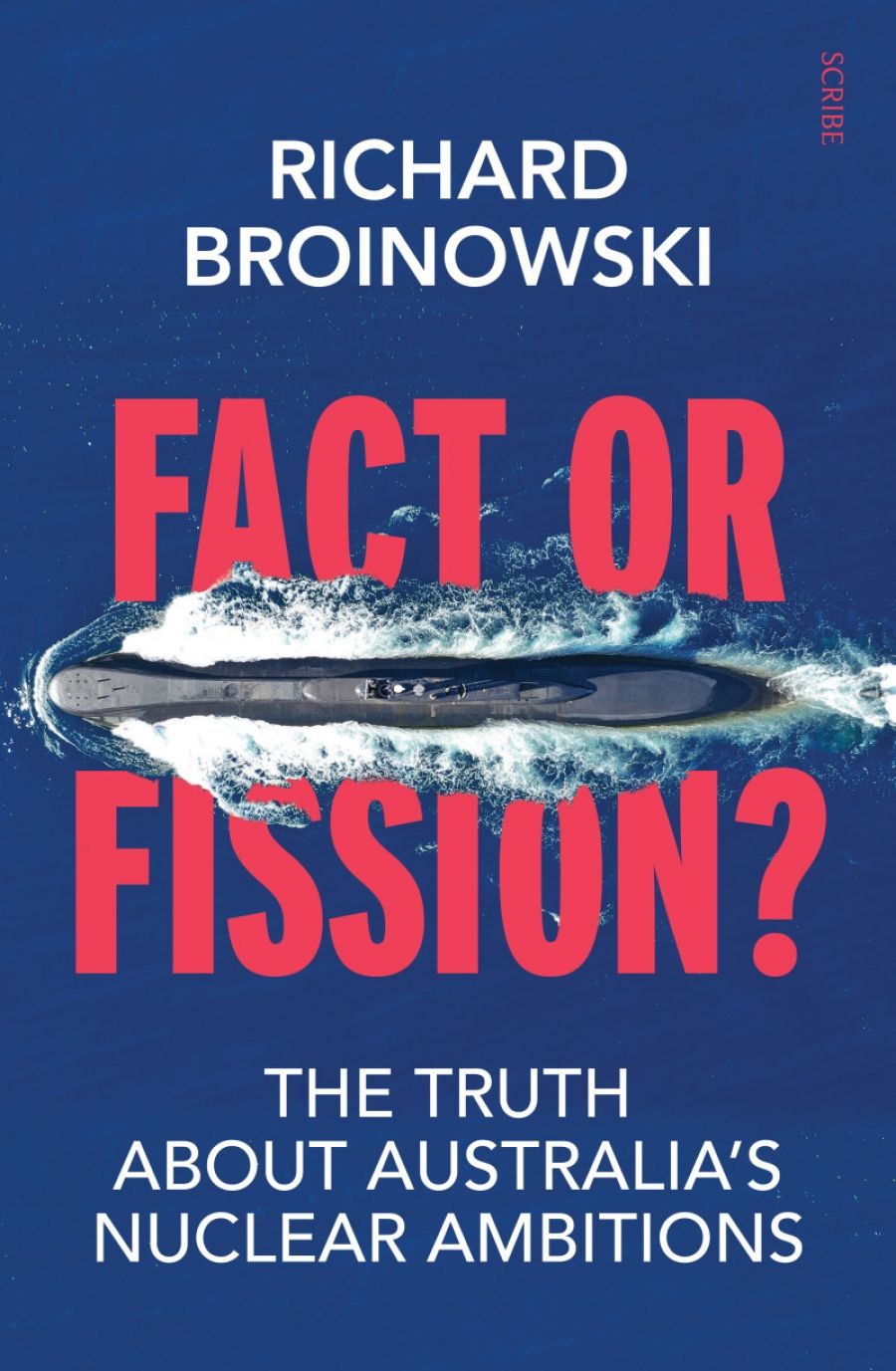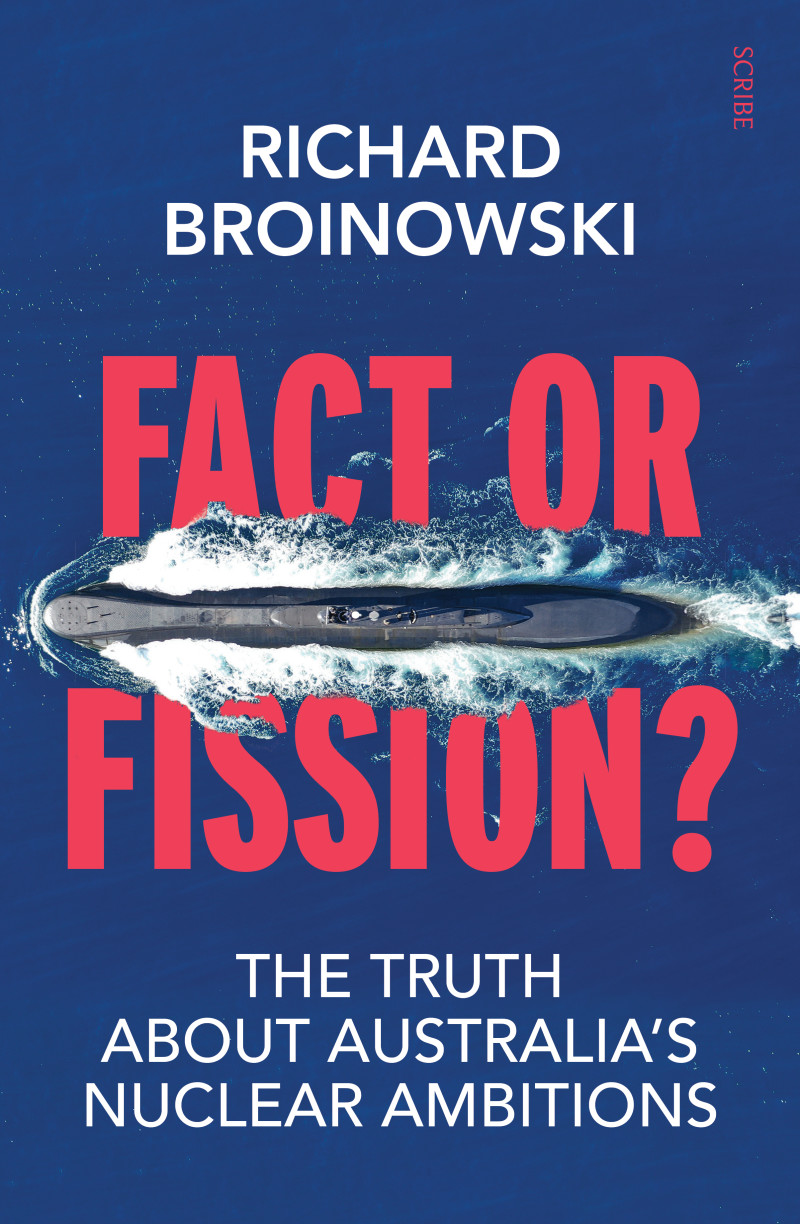
- Free Article: No
- Contents Category: Non-fiction
- Review Article: Yes
- Online Only: No
- Custom Highlight Text:
Richard Broinowski, a retired senior diplomat who has served in seven legations, three as ambassador, has long been interested in matters nuclear, as this excellent work demonstrates. Broinowski traces Australian nuclear developments from the early days of World War II to the most recent developments under Prime Minister John Howard. In the process, he chronicles Australian nuclear ambitions, from the early flirtations with acquiring a nuclear weapon and its related strike capability, to the later development of uranium exports.
- Book 1 Title: Fact or Fission?
- Book 1 Subtitle: The truth about Australia's nuclear ambitions
- Book 1 Biblio: Scribe, $35pb, 331 pp
- Book 1 Cover Small (400 x 600):

- Book 1 Cover (800 x 1200):

What, then, does Broinowski add to our understanding? He brings to this narrative an insider’s perspective of Australia’s nuclear history. We are introduced to the characters who have jockeyed behind the scenes to influence Australian nuclear policy. There is further evidence in this work for Mark Oliphant’s attempts to play down the dangerous effects of nuclear testing and of Australian Atomic Energy Commission (AAEC) head Phillip Baxter’s attempts to keep open Australia’s ability to manufacture nuclear weapons. Sir James Plimsoll, in External Affairs, on the other hand, wanted Australia to be in a position to manufacture such weapons, but not actually to do so. It was a view that seemed to be championed in External Affairs, of all the departments that bought into the nuclear debate the most conscious of Australia’s international position. The department was particularly aware that the Atomic Energy Commission’s flirtation with the French nuclear industry carried real risks. Paris had refused to sign the NPT and was in the process of building its nuclear force de frappe by nuclear tests in the Pacific. Broinowski also reveals the various attempts by commercial interests – from overseas customers, the companies and the Department of Trade – to water down safeguards on the export of Australian uranium. Ultimately, we are told, Australia simply cannot trace the final destination of its exported uranium. It has, for example, been sold to Finland, only to find itself reprocessed in the Soviet Union.
Broinowski speculates about Australia’s development of its own nuclear fuel cycle or, alternatively, the further processing of uranium before it is exported. Herein we are given hints of some Australian attempts to engage in uranium enrichment, especially under Gough Whitlam’s energy czar, Rex Connor, but details are not developed. It is clear that steps in this direction by Australia – and others – in the 1970s evoked a major response from the US, especially after the Indians detonated a nuclear device in 1974. Had Australia unilaterally moved to develop enrichment technology, ANZUS would have been put at risk.
While, in many respects, this is a work by a diplomat about Australian nuclear diplomacy and other diplomats, there is also a creditable attempt to tease perspectives from a number of nuclear scientists and engineers at the AAEC. We are given insights into the uranium mining industry – a major focus in this work – and into the discussions about a replacement reactor for Lucas Heights. While the ongoing role of Lucas Heights and its scientific community are given little attention, there is interesting speculation about the role of ANSTO, the successor to the AAEC, which was set up after 1987 to ‘support Australia’s strategic and nuclear policy objectives’. The question, asks Broinowski, is whether this opens the door to further military-related research.
That is the achievement of this book. Despite the barrenness of writing on nuclear history in Australia, there has been a growing awareness internationally that the end of the Cold War did not bring about the end of concerns about nuclear weapons. Quite the contrary. Broinowski details the very real threats of nuclear terrorism, especially following the collapse of the Soviet Union. As the world increasingly turns to nuclear power, the problem of accounting for fissile material will become ever more pressing. Between 1992 and 2002, forty kilograms of weapons grade material were stolen from poorly protected nuclear facilities throughout the world. Plans are now being prepared by the US to remove, if necessary with force, fissile material from at least twenty-four reactors around the world.
However, it is pointless to look to Washington to go beyond that and to put the nuclear genie back into the bottle. The 1990s US Nuclear Posture review has listed contingencies in which nuclear weapons could be used, a position endorsed by George W. Bush. It was this thinking that spooked North Korea. India and Pakistan have at last cast aside any pretence that their nuclear activities are for peaceful purposes, and Japan, with its vast nuclear industry, could produce weapons in hours, triggering a reaction throughout the Asian region. In that event, Australia would have to do some serious thinking about its own nuclear options. If that eventuates. Broinowski has given us some insights into how those options might unfold.


Comments powered by CComment